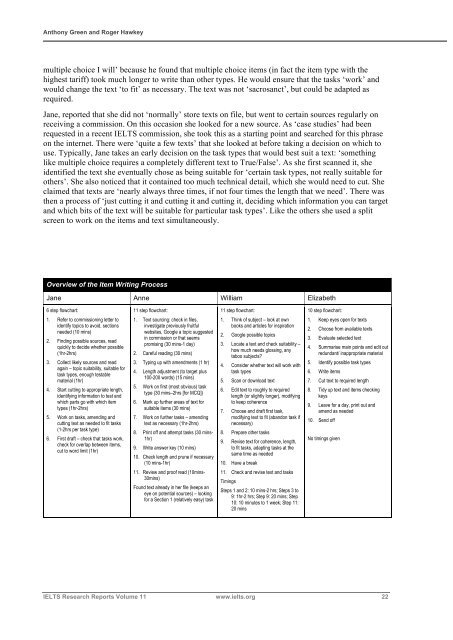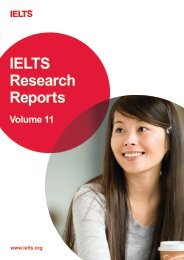An investigation of the process of writing IELTS Academic Reading ...
An investigation of the process of writing IELTS Academic Reading ...
An investigation of the process of writing IELTS Academic Reading ...
You also want an ePaper? Increase the reach of your titles
YUMPU automatically turns print PDFs into web optimized ePapers that Google loves.
<strong>An</strong>thony Green and Roger Hawkey<br />
multiple choice I will’ because he found that multiple choice items (in fact <strong>the</strong> item type with <strong>the</strong><br />
highest tariff) took much longer to write than o<strong>the</strong>r types. He would ensure that <strong>the</strong> tasks ‘work’ and<br />
would change <strong>the</strong> text ‘to fit’ as necessary. The text was not ‘sacrosanct’, but could be adapted as<br />
required.<br />
Jane, reported that she did not ‘normally’ store texts on file, but went to certain sources regularly on<br />
receiving a commission. On this occasion she looked for a new source. As ‘case studies’ had been<br />
requested in a recent <strong>IELTS</strong> commission, she took this as a starting point and searched for this phrase<br />
on <strong>the</strong> internet. There were ‘quite a few texts’ that she looked at before taking a decision on which to<br />
use. Typically, Jane takes an early decision on <strong>the</strong> task types that would best suit a text: ‘something<br />
like multiple choice requires a completely different text to True/False’. As she first scanned it, she<br />
identified <strong>the</strong> text she eventually chose as being suitable for ‘certain task types, not really suitable for<br />
o<strong>the</strong>rs’. She also noticed that it contained too much technical detail, which she would need to cut. She<br />
claimed that texts are ‘nearly always three times, if not four times <strong>the</strong> length that we need’. There was<br />
<strong>the</strong>n a <strong>process</strong> <strong>of</strong> ‘just cutting it and cutting it and cutting it, deciding which information you can target<br />
and which bits <strong>of</strong> <strong>the</strong> text will be suitable for particular task types’. Like <strong>the</strong> o<strong>the</strong>rs she used a split<br />
screen to work on <strong>the</strong> items and text simultaneously.<br />
Overview <strong>of</strong> <strong>the</strong> Item Writing Process<br />
Jane <strong>An</strong>ne William Elizabeth<br />
6 step flowchart:<br />
11 step flowchart:<br />
11 step flowchart:<br />
10 step flowchart:<br />
1. Refer to commissioning letter to<br />
identify topics to avoid, sections<br />
needed (10 mins)<br />
2. Finding possible sources, read<br />
quickly to decide whe<strong>the</strong>r possible<br />
(1hr-2hrs)<br />
3. Collect likely sources and read<br />
again – topic suitability, suitable for<br />
task types, enough testable<br />
material (1hr)<br />
4. Start cutting to appropriate length,<br />
identifying information to test and<br />
which parts go with which item<br />
types (1hr-2hrs)<br />
5. Work on tasks, amending and<br />
cutting text as needed to fit tasks<br />
(1-2hrs per task type)<br />
6. First draft – check that tasks work,<br />
check for overlap between items,<br />
cut to word limit (1hr)<br />
1. Text sourcing: check in files,<br />
investigate previously fruitful<br />
websites, Google a topic suggested<br />
in commission or that seems<br />
promising (30 mins-1 day)<br />
2. Careful reading (30 mins)<br />
3. Typing up with amendments (1 hr)<br />
4. Length adjustment (to target plus<br />
100-200 words) (15 mins)<br />
5. Work on first (most obvious) task<br />
type (30 mins–2hrs [for MCQ])<br />
6. Mark up fur<strong>the</strong>r areas <strong>of</strong> text for<br />
suitable items (30 mins)<br />
7. Work on fur<strong>the</strong>r tasks – amending<br />
text as necessary (1hr-2hrs)<br />
8. Print <strong>of</strong>f and attempt tasks (30 mins-<br />
1hr)<br />
9. Write answer key (10 mins)<br />
10. Check length and prune if necessary<br />
(10 mins-1hr)<br />
1. Think <strong>of</strong> subject – look at own<br />
books and articles for inspiration<br />
2. Google possible topics<br />
3. Locate a text and check suitability –<br />
how much needs glossing, any<br />
taboo subjects?<br />
4. Consider whe<strong>the</strong>r text will work with<br />
task types<br />
5. Scan or download text<br />
6. Edit text to roughly to required<br />
length (or slightly longer), modifying<br />
to keep coherence<br />
7. Choose and draft first task,<br />
modifying text to fit (abandon task if<br />
necessary)<br />
8. Prepare o<strong>the</strong>r tasks<br />
9. Revise text for coherence, length,<br />
to fit tasks, adapting tasks at <strong>the</strong><br />
same time as needed<br />
10. Have a break<br />
1. Keep eyes open for texts<br />
2. Choose from available texts<br />
3. Evaluate selected text<br />
4. Summarise main points and edit out<br />
redundant/ inappropriate material<br />
5. Identify possible task types<br />
6. Write items<br />
7. Cut text to required length<br />
8. Tidy up text and items checking<br />
keys<br />
9. Leave for a day, print out and<br />
amend as needed<br />
10. Send <strong>of</strong>f<br />
No timings given<br />
11. Review and pro<strong>of</strong> read (10mins-<br />
30mins)<br />
Found text already in her file (keeps an<br />
eye on potential sources) – looking<br />
for a Section 1 (relatively easy) task<br />
11. Check and revise text and tasks<br />
Timings<br />
Steps 1 and 2: 10 mins-2 hrs; Steps 3 to<br />
9: 1hr-2 hrs; Step 9: 20 mins; Step<br />
10: 10 minutes to 1 week; Step 11:<br />
20 mins<br />
<strong>IELTS</strong> Research Reports Volume 11 www.ielts.org 22

















